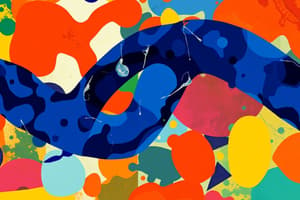Podcast
Questions and Answers
What is the molecular weight of the Fab portion of the Ig?
What is the molecular weight of the Fab portion of the Ig?
- 7S
- 19S
- 11S
- 45 kDa (correct)
What is the main characteristic feature provided by the Fc portion of the immunoglobulins?
What is the main characteristic feature provided by the Fc portion of the immunoglobulins?
- Combination with the antigenic determinant (Epitope)
- Crystallization into pure protein crystals (correct)
- Variability in the position of amino acids
- Flexibility to bind two antigenic sites at the same time
Which immunoglobulin has the heaviest molecular weight according to Svedberg's unit?
Which immunoglobulin has the heaviest molecular weight according to Svedberg's unit?
- IgA
- IgM (correct)
- IgG
- IgE
What is the function of the paratope in the Fab portion of the antibody?
What is the function of the paratope in the Fab portion of the antibody?
What are the hypervariable areas in the variable portion of Ig called?
What are the hypervariable areas in the variable portion of Ig called?
What holds together the 4 polypeptide chains in an Ig molecule?
What holds together the 4 polypeptide chains in an Ig molecule?
What is the main source of synthesis for γ-globulin?
What is the main source of synthesis for γ-globulin?
How many polypeptide chains make up an Immunoglobulin (Ig) molecule?
How many polypeptide chains make up an Immunoglobulin (Ig) molecule?
In an Ig molecule, how many types of light chains can be present on both arms?
In an Ig molecule, how many types of light chains can be present on both arms?
What is the basis for classifying Ig into different types?
What is the basis for classifying Ig into different types?
What is the primary function of the paratope in an antibody?
What is the primary function of the paratope in an antibody?
Which type of gamma globulin primarily provides passive immunity to newborns?
Which type of gamma globulin primarily provides passive immunity to newborns?
What is the main source of synthesis for IgA antibodies?
What is the main source of synthesis for IgA antibodies?
Which region of an antibody molecule determines its class (e.g., IgM, IgG, IgA, etc.)?
Which region of an antibody molecule determines its class (e.g., IgM, IgG, IgA, etc.)?
What is the main characteristic feature provided by the Fc portion of immunoglobulins?
What is the main characteristic feature provided by the Fc portion of immunoglobulins?
In an IgM molecule, how many antigen-binding sites are present?
In an IgM molecule, how many antigen-binding sites are present?
What is the etiology of syphilis?
What is the etiology of syphilis?
Which disease is characterized by the presence of Shigella bacteria?
Which disease is characterized by the presence of Shigella bacteria?
What is the pathophysiology of erythroblastosis fetalis?
What is the pathophysiology of erythroblastosis fetalis?
What is the main focus of the laboratory diagnosis of PUO?
What is the main focus of the laboratory diagnosis of PUO?
Flashcards are hidden until you start studying
Study Notes
Immunoglobulin Structure and Function
- The molecular weight of the Fab portion of the Ig is not specified in the text, but it can be mentioned that Fab is the antigen-binding fragment of an antibody.
- The Fc portion of immunoglobulins provides the main characteristic feature of activating the complement system and binding to Fc receptors.
Immunoglobulin Types
- IgM has the heaviest molecular weight according to Svedberg's unit.
- The basis for classifying Ig into different types is based on the amino acid sequence of the heavy chain constant region, which determines the class (e.g., IgM, IgG, IgA, etc.).
Antibody Function
- The paratope is the region in the Fab portion of the antibody that recognizes and binds to the specific epitope of the antigen, providing the primary function of recognizing and binding to specific antigens.
Immunoglobulin Structure
- The four polypeptide chains in an Ig molecule are held together by disulfide bonds and non-covalent interactions.
- Each Ig molecule consists of two heavy chains and two light chains, with two types of light chains (κ or λ) that can be present on both arms.
- The main source of synthesis for γ-globulin is plasma cells.
Passive Immunity and IgA Synthesis
- IgG provides passive immunity to newborns.
- The main source of synthesis for IgA antibodies is mucosal tissues, such as those found in the gut and respiratory tract.
Laboratory Diagnosis
- The main focus of the laboratory diagnosis of PUO (pyrexia of unknown origin) is not specified in the text.
- Shigella bacteria are the causative agents of bacillary dysentery.
- The etiology of syphilis is not specified in the text, but it is caused by the bacterium Treponema pallidum.
- Erythroblastosis fetalis is a hemolytic disease of the newborn, caused by maternal-fetal incompatibility of the Rh blood group.
Studying That Suits You
Use AI to generate personalized quizzes and flashcards to suit your learning preferences.



